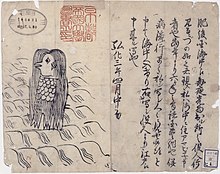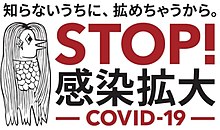Amabie
Amabie (ア マ ビ エ) is a mythological Japanese mermaid or merman with three legs who is said to rise from the sea and foretell either a good harvest or an epidemic . It appears to be a variant of Amabiko (ア マ ビ コ, 海 彦, 尼 彦, 天 日子, 天 彦, あ ま 彦, i.e. amahiko ), also known as amahiko-nyūdo (尼 彦 入道), and aria (ア リ エ), which are called depicted as monkey-like, bird-like or cephalopod- like (without torso ), usually 3-legged.
Legend
According to legend, an amabie appeared in the province of Higo ( Kumamoto Prefecture ) around the middle of the fourth month in the year Kōka -3 of the Edo period . During the night, a glowing object was seen in the sea almost every day. The city official went to the coast to watch and examine the amabie. According to one sketch, it had long hair, a mouth like a bird's beak, was covered with scales from the neck down, and was tripod. It introduced itself to the officer as Amabie and told him that it lived on the open sea. It conveyed the following prophecy: “This year there will be a good harvest for six years; when a disease spreads, draw a picture of me and show it to those who get sick and they will be cured. ”Then it returned to the sea. The story was printed in the Kawaraban (woodcut notice), including her picture, which spread the story in Japan.
Amabiko group
There is only one record of the amabia, the meaning is unclear. It is speculated that the amabie is simply a flawed copy of the "amabiko", a yōkai creature that can be considered identical. Like the amabia, the amabiko is a multi-legged, prophetic creature that recommends showing one's own image as a cure and defense against illness and death.
There are at least nine surviving reports of Amabiko or Amahiko (尼 彦) (variant: 海 彦, 天 彦): four described apparitions in the province of Higo , a report by the Amabiko Nyūdo (尼 彦 入道, "the amahiko monk") in neighboring Hyūga Province ( Miyazaki Prefecture ). In addition to the bundled occurrence in the south, there are also two occurrences in the province of Echigo in the north.
Version without torso : An illustrated manuscript about an encounter in Echigo in 1844 shows a more cephalopod- like amabiko , consisting of a head with three long, protruding appendages and almost no upper body. She has "short hair that grows all over the body, including the face, with human-like ears, round eyes and a slightly protruding mouth." The creature explains that 70% of the Japanese population will be doomed to death this year, but that this could be averted by showing its representation.
Monkey -like version : A monkey-like amabiko (尼 彦) from Higo province appears in a painting owned by Kōichi Yumoto, an authority on research on yōkai . The text refers to the discovery of this amabiko by Shibata Hikozaemon, who heard monkey sounds at night and followed them. Yumoto insists that this drawing depicts a four-legged friend, but there have also been depictions of ape-like amabiko that were printed en masse and contained a similar article in which only three legs were visible, such as Yūbin Hōchi Shinbun in an article dated June 10, 1876 reported. The texts both report sightings of the ape-like creature in Mana-kōri (眞 字 郡), a non-existent district in the province of Higo.
Amabiko-no-mikoto : The Amabiko-no-mikoto (天 日子 尊, the holy Amabiko ) was sighted in a rice field in Yuzawa , Niigata , as reported by the Tokyo Nichinichi shinbun on August 8, 1875. The rough illustration of the newspaper shows a Daruma doll-like, hairless-looking, four-legged creature. This example stands out because it was not discovered in the sea but in a damp rice field. It explained that it served the heavenly gods (of Shinto) and had been given the imperial / divine title "mikoto".
Aria : According to the newspaper Kofu Nichinichi Shimbun of June 17, 1876, a similar creature called Aria (ア リ エ) appeared in the district of "Aotori-kōri", Higo province. However, this report was refuted by another magazine.
COVID-19
Amabie became a popular topic on Twitter in Japan during the COVID-19 pandemic . Manga artists (e.g. Chika Umino , Mari Okazaki and Toshinao Aoki) published their cartoon versions of the Amabie on social networks. The Twitter account of Orochi Do, one on Yōkai - scrolls specialized art business, is to end in February 2020 as the first "a new COVID-19 -Gegenmaßnahme" tweeted.
swell
- ↑ a b c d e f g Nagano, Eishun (長野 栄 俊) (2005), "Yogenjū amabiko — amabiko wo tegakari ni"予 言 獣 ア マ ビ コ 考 - 「海 彦」 を て が か り に[Consideration on prophetic beast amabiko — using umibiko as hint] (PDF), Jakuetsu Kyōdoshi Kenkyū (若 越 郷 土 研究) , 49 (2): 1–30, archived from the original (PDF) on August 16, 2016, retrieved June 29 2016.
- ↑ a b Yumoto, Kōichi (湯 本 豪 一): Nihon genjū zukan 日本 幻 獣 図 鑑 [Japan imaginary beasts illustrated] (in Japanese). Ed .: Kawaide Shobo. 2005, ISBN 4-309-22431-8 .
- ↑ Yumoto, Kōichi (湯 本 豪 一) (1999): Meiji yōkai shimbun 明治 妖怪 新聞[ Meiji era yōkai newspaper. ] (in Japanese). Kashiwa Shobo, 1999, ISBN 4-7601-1785-7 , pp. 196-198.
- ↑ Plague-predicting Japanese folklore creature resurfaces amid coronavirus chaos. In: The Mainichi. March 25, 2020, accessed May 28, 2020 .
- ^ From Japan, a Mascot for the Pandemic. In: The New Yorker. April 9, 2020, accessed on May 28, 2020 .


